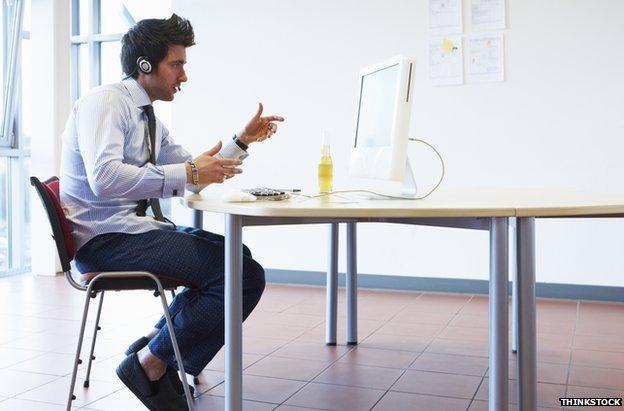Skype interviews: Is it more tricky to be grilled by video?
- Published

The job interview is an ordeal that most people face at some stage in our career. But as video starts to take the place of the face-to-face interview, is it easier or harder now to land your dream job?
The job interview as we know it may never have existed if it wasn't for Thomas Edison.
Frustrated with hiring college graduates who lacked the right knowledge, Edison devised the first employment questionnaire, external to narrow down his applicant pool.
The survey was thought to be so difficult that in 1921 the New York Times nicknamed it a "Tom Foolery test" and claimed only a "walking encyclopaedia" could succeed.
Questions included: "What is the weight of air in a room 20ft x 30ft x 10ft?" and "Where are condors to be found?"*
But today the trick to making a good impression at interview may be less about what you know and more about how you come across on camera.
Jean Luc, a 30-year-old marketing professional from Greenwich, recently had his first video interview for a role at a web start-up company based in Berlin.
"I had the usual nerves before my interview. But I Skype all the time as my parents live in South Africa so it felt like a much more familiar process. What I found quite disconcerting was when I first turned on the video, my interviewer had his camera turned off.
"It would have been awkward if I turned my camera off and on again so I just went through the interview with a black screen. It was a bit like talking to myself."
Looking in the wrong place is just one of the common pitfalls of video interviews, says New York-based career coach and blogger Megan Broussard.
"It's tempting to watch yourself in that little box to make sure your hair isn't in your face or that you're not making weird facial expressions. But the truth is that it is very distracting to the other party and can come across as shy and even insincere - two qualities both employers and new hires want to avoid.
"It's OK to watch the speaker on the screen, but respond by looking into the camera to create the illusion of direct eye-contact, always."
In the US more than six out of 10 HR managers, external now use video to interview job applicants, according to a survey.
A growing number of UK firms are adopting a similar approach, says Claire McCartney, from the Chartered Institute of Personnel and Development (CIPD).
"Video interviewing is becoming an attractive option as organisations branch out overseas," says McCartney.
As well as live interviewing on services like Skype, some firms are giving video "questionnaires" for candidates to record.
The UK company, Webrecruit, reports a steady increase in the use of automated video interviewing over the past few years. Employers can view recorded responses from candidates in their own time.
"Clients will input their questions, then the candidate receives an automated email inviting them to sit the interview," explains Webrecruit's Leona Matson. "The interviewee can then sit the interview within an allocated time frame, the answers are recorded, and then the client can view it at a time that suits them."
As hiring becomes more global for candidates and employers, video interviews can be much more cost-effective.
In 2012 employers in the UK spent an average of 10 working days interviewing, 16% of the working week travelling to meet candidates and £3,286 reimbursing candidates' travel expenses, according to a survey carried out by Cammio - a Dutch company specialising in online video services.
"The significant drain on time and resources companies face when scheduling and carrying out interviews means for many, it can be an expensive and time-consuming task," says Matson.
For large firms with international graduate schemes, the savings can be significant. Sellafield's graduate scheme cited cost savings of £14,000 using video technology to screen interview candidates.
The European Organization for Nuclear Research (CERN) also report cutting recruitment costs by 20% using automated video assessments for first-round interviews.
First impressions are still crucial.
"You can definitely gain a better first impression of candidates using a combination of video and CV rather than their CV only," says Walter Hueber, chief executive of Cammio. "It's much more visual and allows you to get a broader assessment of the candidate."
But does the technology give the younger generation an unfair advantage?
"It can take some getting used to," says Peter Russell of VuCall, a company offering video consultations based in London. "When we started three years ago, it took some time for people in a business context to feel comfortable seeing themselves on screen. After a while though, they just got used to it and learned to relax."
Jean Luc says he would prefer to do all his interviews via video in future, to avoid unnecessary anxiety.
"This way you avoid the pressure of getting to the interview on time, getting stuck in traffic or worrying so much about what to wear. I felt much more at ease interviewing at home and I was able to think more clearly before responding."
But sometimes you can't beat face-to-face contact says Mike Parker, who runs Pitchcoach, a business communication consultancy.
"I suspect that for senior jobs face-to-face will continue. You can't see the handshake. You can't see how they walk into the room.
"Half of all business travel, in theory, could be substituted with telecommunications, but it isn't. Why?"
*Want to know the answers?

Where are condors to be found?
Andean condors live in South America, in the mountains of the Andes, but also near coasts - for the ocean breezes - and deserts with strong thermal air currents. California condors, external live in southern California and parts of Arizona, and are endangered.
What is the weight of air in a room 20ft x 30ft x 10ft?
It's 480lb, or 218kg. The air mass, or weight equals volume times air density.
20 x 30 x 10 = 6,000 cubic feet
air density is about 0.08lb a cubic foot at standard temperature and pressure, so:
6,000 x 0.08 = 480lb
You can follow the Magazine on Twitter, external and on Facebook, external